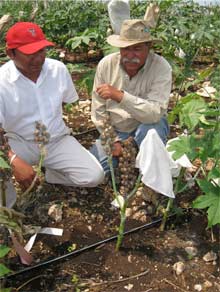Company Aims to Make Better Biofuel Crops
An agricultural company spun out of biotechnology powerhouse Synthetic Genomics will develop higher-yield biofuel crops. It will also develop combinations of microbes designed to supplement chemical fertilizers and pesticides used in corn and wheat production. Called Agradis, the San Diego-based startup was formed with the Mexican investment firm Plenus. The company announced last week that it has raised $20 million in series A funding.

Half the company’s efforts will go to developing two promising biofuel crops, sweet sorghum and castor plants, says J. Craig Venter, CEO of Synthetic Genomics, who will serve as chairman of Agradis. “We’re looking for fuel crops that don’t need prime growing conditions,” and that won’t compete with food crops for land, says Venter. The company will develop higher-yielding varieties of both plants using a combination of traditional plant breeding and genomics approaches, such as genetic engineering and genome sequencing.
Today, sorghum is the number two biofuel crop in the United States after corn; the seeds are high in sugar and are processed to make ethanol. But sorghum has some advantages over corn. It’s drought-tolerant and requires less water than corn to grow, which makes it a more sustainable option. To make it competitive with corn for making ethanol, however, researchers need to boost the amount of sugar in its seeds.
Castor beans are pressed to make an oil that’s in limited use as a biodiesel today. It is mostly used for industrial lubricants. Again, the key to the success of this plant as a fuel crop is yield—the amount of oil each plant can produce. “If we could double the yield, it would be the best oil-producing plant there is,” says Venter. Researchers at the Venter Institute, a nonprofit research institution also headed by Venter, led the effort to sequence the castor genome, a project that was completed last year.
Andrew Paterson, who led the sorghum genome sequencing project, completed in 2009, says that doubling the yield of any plant is a tall order. Using conventional techniques, “in 50 years you’d do very well to double the yield,” he says. Sorghum and castor only go through two or three generations a year, so conventional manipulation of these crops takes time.
Plenus has already been working on these crops using traditional methods; Agradis will now apply some genomic methods licensed from Synthetic Genomics. Venter would not comment on what methods the company will be using to improve the yields. But as Paterson notes, “the scope of what you can do is expanding as the cost of sequencing is dropping like a rock.”
The other half of Agradis’s efforts will be aimed at developing communities of microbes that can be applied to corn and wheat seeds to promote growth and prevent disease throughout the plant’s lifetime. Over the past few years, researchers at Synthetic Genomics have been using high-throughput DNA sequencing and screening methods to study the rhizosphere, the microbial communities found on and around plant roots. They’ve found that, just like the microbes living in the human digestive tract, these plant-associated microbes play a critical role in regulating health and disease.
Agradis has licensed a library of thousands of plant-associated microbes from Synthetic Genomics, as well as methods for rapidly screening them in the lab and in plants for disease prevention or promotion. Agradis’s microbial seed coatings are currently in testing in greenhouses.
Keep Reading
Most Popular
Large language models can do jaw-dropping things. But nobody knows exactly why.
And that's a problem. Figuring it out is one of the biggest scientific puzzles of our time and a crucial step towards controlling more powerful future models.
The problem with plug-in hybrids? Their drivers.
Plug-in hybrids are often sold as a transition to EVs, but new data from Europe shows we’re still underestimating the emissions they produce.
Google DeepMind’s new generative model makes Super Mario–like games from scratch
Genie learns how to control games by watching hours and hours of video. It could help train next-gen robots too.
How scientists traced a mysterious covid case back to six toilets
When wastewater surveillance turns into a hunt for a single infected individual, the ethics get tricky.
Stay connected
Get the latest updates from
MIT Technology Review
Discover special offers, top stories, upcoming events, and more.